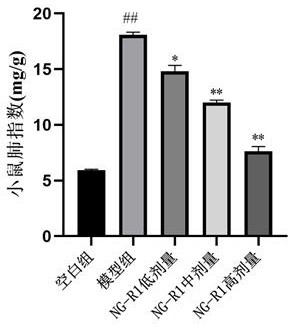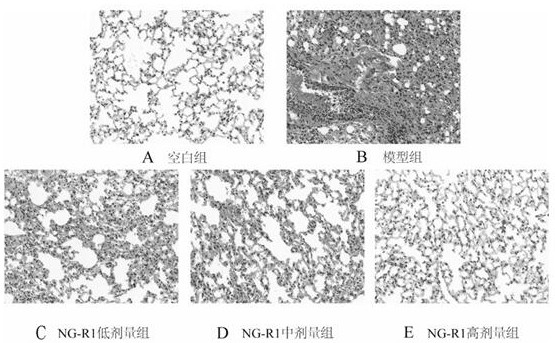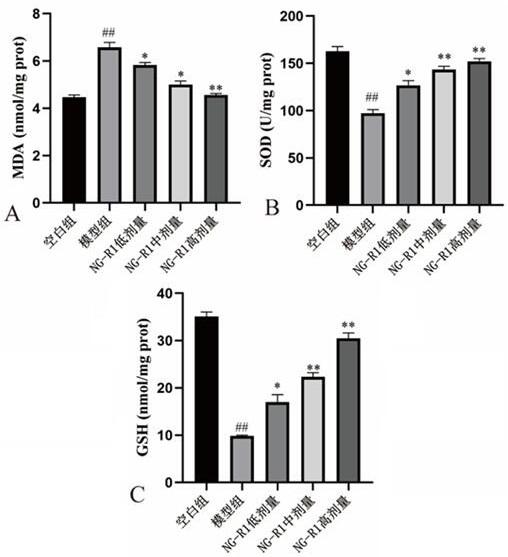New application of notoginsenoside R1
A technology of notoginsenoside and acute lung injury, applied in the field of medicine development and preparation
- Summary
- Abstract
- Description
- Claims
- Application Information
AI Technical Summary
Problems solved by technology
Method used
Image
Examples
Embodiment 1
[0017] Embodiment 1: Grouping and administration of animal experiments
[0018] 50 C57BL / 6 male mice were randomly divided into 5 groups (10 in each group): blank control group, model group, notoginsenoside R1 treatment group including low-dose group (50mg / kg), middle-dose group (100mg / kg) kg), high dose group (200mg / kg). The mice in the model group and the treatment group were intraperitoneally injected with 10 mg / kg LPS once to construct a mouse model of acute lung injury; the mice in the blank group were injected intraperitoneally with the same volume of normal saline as in the model group; For drug treatment, the blank group and the model group were intragastrically administered distilled water every day, and the treatment group were intragastrically administered notoginseng saponin R1 50mg / kg, 100mg / kg, and 200mg / kg every day, for 21 consecutive days.
Embodiment 2
[0019] Example 2: Sample Collection
[0020] After 21 days, all the experimental mice were executed, and the weight of the mice was weighed before the execution. The lung tissues of the mice were taken out, washed with normal saline, and the excess water on the surface was wiped off, weighed, and the morphological changes of the lungs of the mice were observed. Normal mice had severe lung enlargement; after treatment with notoginseng saponin R1, the lung enlargement gradually improved, and the mouse lung index (mg / g)=lung weight was calculated according to the mouse body weight and lung weight when sacrificed (mg) / mouse body weight (g), the result is as follows figure 1 As shown, the lung index of the mice in the model group was much higher than that of the treatment groups.
Embodiment 3
[0021] Example 3: Pathological detection of mouse lung histopathology
[0022] The lung tissue was fixed with 10% neutral formaldehyde solution and dehydrated with ethanol gradient, transparent in xylene, embedded in paraffin, sliced (thickness 4 μm), and the excised tissue slices were gently placed on 30% ethanol for the first exhibition. Then transfer the slides to a water bath at 45°C, stretch them for the second time, and attach them to the slides when the slices are completely unfolded; place the slices on a stand and dry them in a 37°C oven for subsequent H&E staining.
[0023] The specific operation steps of H&E staining are as follows: put the dried slices into xylene I and xylene II respectively for 5 minutes each, and dissolve the paraffin on the slices; take out the slices from xylene, and transfer them into absolute ethanol in sequence , 95% ethanol, 80% ethanol, and 70% ethanol, stay for 2 minutes each, and finally wash with running water for 5 minutes; move the...
PUM
 Login to View More
Login to View More Abstract
Description
Claims
Application Information
 Login to View More
Login to View More - R&D Engineer
- R&D Manager
- IP Professional
- Industry Leading Data Capabilities
- Powerful AI technology
- Patent DNA Extraction
Browse by: Latest US Patents, China's latest patents, Technical Efficacy Thesaurus, Application Domain, Technology Topic, Popular Technical Reports.
© 2024 PatSnap. All rights reserved.Legal|Privacy policy|Modern Slavery Act Transparency Statement|Sitemap|About US| Contact US: help@patsnap.com










